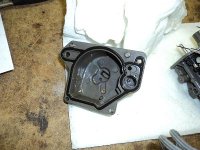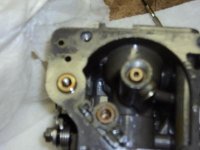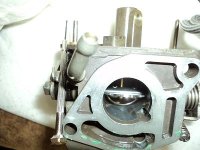See? Ain't this fun?.....Sorry, couldn't resist.
Yes, it sounds like that passage is plugged. Quite common. And, that is a GOOD thing isn't it? To find something wrong that we can fix to get your outboard going? It's way better than the old "I can't find anything wrong" so you don't know where to go next.
Ok, getting that passage clean can be a real pain. Do you have the "jet set" out? Item # 18 and 20 in the link below.
http://www.boats.net/parts/search/H...6/BFP9.9D6 LHTA /CARBURETOR (AUTO)/parts.html
What you have to do is prop the throttle linkage open so that you can see all three orifices at the top of the carburetor throat. I use my little pocket screwdriver wedged in the linkage to keep it wide open while I work. The orifices are tiny little drillings arranged in a sort of triangle pattern at the back top of the venturi (throat). One of them is the idle orifice and can actually be seen when the throttle plate is closed. The other two are the transition and main orifices and cannot be seen or accessed with the throttle closed.
In order to clear that pump passage, you need to flush, then backflush, then flush, then backflush until it is clear. If you have the jet set out, put it back so that you can hold your finger over the tube so that you can plug the passage there and force the cleaner to take a direct path to and from the orifices. Take the straw from your carb cleaner and carefully position it over either the main or the transition orifice and give it a good shot. Then, still holding your finger over the jet set, you go back and shoot the passage. You must keep doing this, back and forth, until you get it to flow. It can take a while. I have never had one that I couldn't get working but there is always a first time I guess.
You will know when that passage is clear when you shoot into the feed side and carb cleaner comes out the back of the carb throat in a 6 to 8 foot stream! Don't spray it into your eyes.
Standing by.




